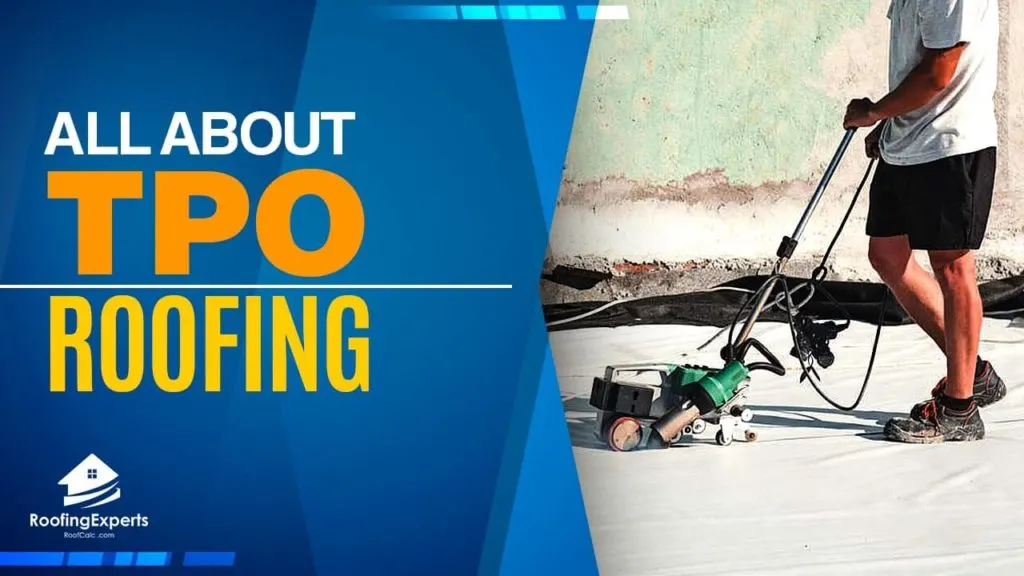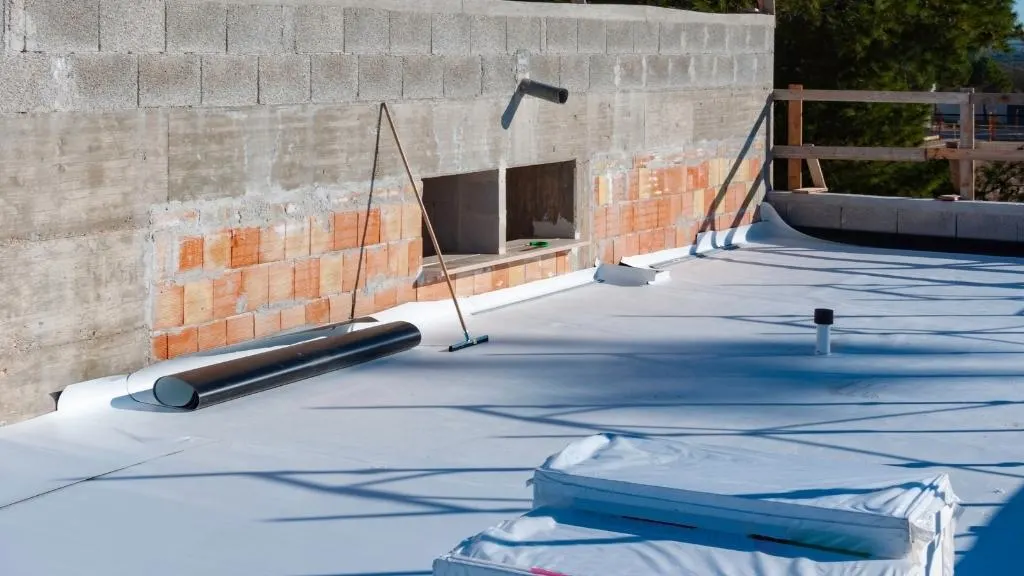
Thermoplastic polyolefin, also known as TPO, is one of the fastest-growing and most popular single-ply roofing materials for flat roofs. If you’ve seen those bright white rooftops on commercial buildings, it’s highly likely TPO. This thin and inexpensive roofing material is gaining recognition amongst building owners who want a durable, reflective roof that’s right within the budget.
Because TPO is in high demand for its energy-efficient and heat-reflective roofing systems, you can rely on TPO single-ply roofing membranes to provide continuous resistance to ozone, ultraviolet, and chemical exposure.
So, if you were looking into learning more about what TPO roofing is, the time is now. In this guide, we will be covering all things TPO roofing.
Single-ply Membranes
Single-ply membranes are sheets made out of rubber and other synthetics, that can either be fastened mechanically, ballasted to a roof, or affixed to the insulation to form a protective layer on a flat roof surface.
While single-ply is a commonly known type of commercial material, there are two types of single-ply membranes that are made to suit the building’s needs for commercial operations as well as your budget.
And those types include:
- Thermoplastic Polyolefin (TPO)
- Ethylene Propylene Diene Terpolymer (EPDM)
These single-ply membranes vary in their type of materials, installation methods, and energy efficiency.
TPO Roofing
In simpler terms, TPO translates to thermoplastic polyolefin. It is made out of a layer of single-ply membrane that is composed of synthetic components, and TPO comes with a fabric reinforcing scrim that helps stabilize and strengthen the membrane for more improved and increased performance.
It consists of different types of rubber that are generally a combination of polypropylene and ethylene-propylene rubber. TPO roofing is more popular among commercial properties, particularly on flat roofs.
Many people using this type of roofing have skyrocketed, as TPO roofing due to its natural reflective ability to deflect ultraviolet waves, all while saving on utility costs and conserving energy.
Manufacturers fabricate the membranes themselves in sheet form and also measure them in widths of 10, 12, and 20 feet. They distribute the sheets once they have been cut, rolled, and assembled, to the facility that has requested and purchased the materials for commercial roofing use.
Installation Of TPO Roofing
After preparing the materials, cleaning, and removing the substrate一or the surface the TPO roofing will be installed一put the new insulation in place. There are a few options with insulation you can select:
Polyisocyanurate (Polyiso)
This is one of the most often used insulation types for roofing applications. As this can be costly, it also has an R-value rating, which measures the resistance to the flow of heat on a material. Having this top rating only means that the insulation has a strong ability in withstanding heat.
Expanded Polystyrene (EPS)
This type of insulation has one of the highest R-value ratings and is used in roofing and flooring and wall insulations. It’s highly resistant to water and can be used when connecting to the ground as part of the insulation process.
Extruded Polystyrene (XPS)
Characterized by its colors一usually pink, blue, or green一this type of insulation’s performance and cost are in a range between Polyiso and EPS. It has a perm rating of 1 and is made up of semipermeable material.
A perm rating measures the rate of water vapor that flows through a square roof of a material. Having a high perm rating is liken to a more significant amount of water vapor that’s passing through roofing material or any material for that matter.
Having a lower score, such as 1, equates to a smaller amount of water vapor passing through the roof’s material.
TPO Adherence/Attachment
A TPO membrane is usually either mechanically fastened or affixed using an adhesive that binds it to the cover board. Once it has been rolled into place, the seams created are to be welded together with a hot-air gun.
TPO Roofing Costs
There are many factors to be considered when it comes to the overall costs of single-ply materials as well as their installation. Though you can opt for inexpensive materials, there are still a few things to consider for you to be able to get the best out of the materials at a fair price.
To get a more cost-effective solution for your property, you should take these factors into account:
- The condition of your roof
- The roof’s size
- Access to the roof
- Insulation of your choice
- The membrane of your choice
- Installation preferences
- The roof’s protrusions/penetrations
- The type of warranty
Advantages Of TPO
With TPO’s proper installation and maintenance, single-ply membranes can last up to about 30 years. There are other benefits to using single-ply membranes, such as:
Insulation options – Using single-ply roofing systems excludes the insulation factors, so being a commercial roofing consumer, you have the power to choose from a variety of options for your roof’s insulation.
Installation options – There are a lot of options for installing a single-ply roof, and it can be fastened or attached right to a roof deck, or affixed with different types of adhesive. It can also be welded using heat in more difficult parts of the roof, such as chimneys, protrusions, and projections.
Corrosion resistance over time – TPO is invulnerable to corrosion and disintegration when it comes to contact with different types of materials, as well as being resistant to mildew and algae, so it’s very easy to maintain.
Class A Fire-Rated, both EPDM and TPO membranes are Class A-fire resistant. During its processing, manufacturers add fire retardant chemicals to the composition of the material.
Reflective and retentive – Most TPO is generally white and extremely reflective, while EPDM, in contrast, is often black because of its natural color and is retentive to the sun’s rays.
Disadvantages Of TPO
Although TPO can be considerably inexpensive, many TPO products are different in their construction and qualities. The product’s wide range of thicknesses can often be a problem due to consumers’ thinking that the thicker the product, the more TPO is long-lasting and has better quality.
With that said, even if consumers buy thicker TPO products, they still deteriorate and weaken all the same. Various materials in TPO have changed over the years, which makes it a bit difficult to tell for sure how long the TPO roof is going to last. An overall estimate will be from 15 to 20 years.
Having limited durability can produce weak spots that cause disintegration, as well as cracking or splitting of the roof’s surface.
How Does TPO Help You Save Money?
As single-ply membrane roofing has become one of the top roofing materials for most commercial facilities’ needs, they are cost-effective for businesses opting for TPO.
With TPO’s highly reflective features, money is to be saved, especially on energy uses during summer or the warmer months of the year. While the interior of a building remains cool, the utility consumption lessens.
How Is A TPO Roof Repaired?
Typically, TPO roofing will last between 15 to 20 years. In this time, seams can rip apart, membranes can become punctured or damaged, flashings can fall, and other things that can break it, and cause leaks in the roof.
The first sign you need to watch out for to know when your TPO roof needs repairing is when the water has begun entering the building. This happens usually when the seams have been ripped open, and when that happens, it allows water to enter the roofing installation.
Once the insulation has gathered so much water, it enters the roof deck, and in the course of time, starts leaking inside your building.
At this rate, it’s time to call a commercial roofing contractor to do a roofing investigation to be able to tell which areas need repairing.
Here are a few things the contractor would be able to tell during the roof inspection;
- How old your TPO roof is
- Which part of your roof’s insulation is leaking water
- How many layers your roof has
- The seams’ conditions
With all the things the contractor will take into consideration while inspecting the roof, the building owner will be given different roof repair options.
Conclusion
Typical commercial flat roof membranes should last about 20 to 25 years before it needs to be replaced. If not maintained, they could last for 10 years and would be needing replacements early on. And when it is properly maintained, it could last for up to 50 years.
Although it always depends on the climate, maintenance, the quality of the installation, the type of membrane used, and roof penetrations. Given the performance and durability of TPO, it is the preferred option for most commercial construction projects.
In theory, TPO roofing lasts longer because they are more durable and provide naturally reflective surfaces that help reduce UV radiation penetration and is more energy-efficient.
When it comes to costs, TPO is one of the cheaper alternatives, however, the amount of labor needed during its intensive installation. Additionally, if the contractor chooses to use glued seams over welded seams it will take too much work compared to other types of roofing and their installation process. And when using TPO in roofing systems, it’s important to choose a reputable supplier.


